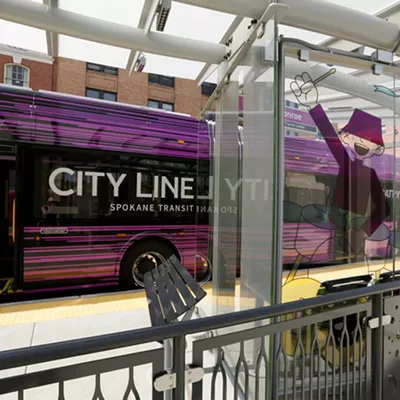Oh, and markers. Lots of colored markers. They were scattered across the tables in the Bookie building's courtyard on the Riverpoint Campus Thursday night. Maps taped to the walls showed brightly colored, dotted, dashed, circled visions of what Spokane's amorphous university district looks like now and what it could look like in the future, with a little smart-growth planning.
The six high-minded consultants came to town from all over the country on a Smart Growth Implementation Assistance grant from the Environmental Protection Agency. The grant, which was awarded to only three other cities, was penned by the city of Spokane and Patrick Jones, executive director of Eastern Washington University's Institute for Public Policy and Economic Analysis, to help identify clear steps toward sustainable development of a university district.
Over three long days, the consultants met with city and university officials, stakeholders and the public. They walked the neighborhood, spent long hours drawing and coloring maps and overlays, and poked through the district's strategic master plan -- drafted by city leadership with community input in 2004.
Among their biggest recommendations was that the city not pursue plans to extend Riverside Avenue through the district (as it's been planning to do for about two years) but to use Main as the primary east-west route. They added that the road shouldn't be a high-speed arterial but a slower two-way street, with one lane going in each direction and a turn lane running down the center.
At a presentation to the city on Friday, Rick Williams of Van Meter Williams Pollack stressed that a slow Main Avenue would diffuse traffic, move it onto multiple streets and make the environment more friendly to pedestrians and bicyclists. A potential five-lane Riverside arterial might move traffic through more quickly, but it could end up just pushing people from one end of the district to the other.
Cody George, the city's economic development adviser, says the city is open to the extended Main Avenue idea, but that it's going to take time. City planners have already spent two years working toward the Riverside extension and have completed 30 percent of the planning -- the realignment could push back the timeline for construction (the city had aimed to start turning dirt on Riverside by the end of this year). George notes that the bulk of the approximately $6.6 million in federal earmarks available to the project hasn't yet been tapped, however. And about $2 million more in state funds is also available.
"We need to now vet [their recommendations] and see what's possible," George says. "Is it realistic? What is the outcome of doing something like that?"
& lt;span class= & quot;dropcap & quot; & T & lt;/span & he consultants pointed out two other priorities. The first was the preservation of the Jensen-Byrd building, a six-story, 178,000-square-foot building near Pine Street, south of Spokane Falls Boulevard. The 97-year-old structure has been eyed closely since December of 2005, when Washington State University put out a request for proposals to redevelop it. Last September, the university received an evaluation of the building by SERA Architects of Portland, which concluded that it would be impossible to profitably redevelop the building within current market conditions.
But Dena Belzer, a planner with Strategic Economics in Berkeley, Calif., disagrees. "I think ... there's plenty of market to support what could go on in the Jensen-Byrd." But she and the rest of the consultants concur that to make it work, the building would need street frontage. It's currently situated at the dead end of Main Avenue.
An extended Main, then, "[would make] it an even more important building and an even more important site," says Rick Williams. Combine that with shared off-site parking, he adds, and it would be a great asset to the district, providing a contrast to the new construction all around. "As an architect, I'd love to build something like that," he says. "You just can't. I can't build in those idiosyncrasies."
The third priority outlined by the team is a bridge that would span the railroad tracks bisecting the district just north of Riverside. The pedestrian/bicycle bridge, they say, is absolutely necessary in connecting the academic buildings in the northern part of the district with the mixed-use residential and commercial area they envision in the south.
Early sketches made for the strategic master plan in 2004 showed something akin to the Ponte Vecchio in Florence, a bulky bridge with a built-in shopping area. Brian Jennings, the city's economic development project manager, says the point wasn't necessarily to emulate Italy's iconic bridge but to create a connection that would feel safe and welcoming, something impressive enough to overshadow the unappealing rail yards it spanned.
"One of the big issues with the pedestrian bridge initially is that, in itself, it has to be kind of a place to be successful," says Jennings.
But the consultants think safety and attractive design can be achieved without the grandeur as long as there's plenty of activity at either end -- transit stops, retail shops, caf & eacute;s, residences, streetlights. It doesn't mean the bridge will be any less grandiose, however. Because it must span a freight rail line and another rail right-of-way (which could potentially be used for light rail in the future), and because both rail lines are on uneven grades, the bridge would have to be some 100 feet long and hang 30 feet in the air. It's going to be "a major structure and a major public investment," Williams says.
& lt;span class= & quot;dropcap & quot; & D & lt;/span & espite the highly speculative nature of the week's events, the consultants don't believe their work is a mere pipe dream. They point to Portland's Pearl District and to Lo-Do in Denver, where an old warehouse district was turned into one of the hippest, most vibrant areas in the city.
The key, they say, is to plan. To draw. To chart out exactly how to turn goals into realities. Each consultant stressed the need to start building the kind of infrastructure that would attract smart development. To wrestle with WSU now in order to save the Jensen-Byrd building. To figure out the alignment for the district's main thoroughfare. To draw what a possible light rail station might look like.
They'll deliver a full report to the city in six to eight weeks. In the meantime, says Cody George, the city will begin to consider a possible street realignment.
You've got to start somewhere, says Rick Williams, one of the consultants. "Grittiness and idiosyncrasies develop over time. That's the great part about an urban environment -- you don't build it all at once. You don't snap your fingers. I think that this is going to be an interesting evolution. I'm kind of getting excited about it."















